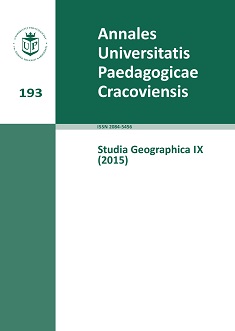Spatial differentiation of medium-sized cities in Poland by volume of commuting to work
Keywords:
commuting to work, mobility measures, shuttle migrations, commuting areaAbstract
Effective management and planning of urban development requires taking into account links between cities and their backends, which are stronger and stronger. Current trends indicate that we should look at the city as a distinct functional unit. Some of its functions cross administrative borders. Consequently, a dense zone of influence is formed around each city. This zone, together with the inner city, creates a functional urban area. The impact of each city is proportional to its size and importance, and inversely proportional to the distance from it. The relationship between the city and its surroundings is determined using functional links, for example commuting to work, education, services, etc. In fact, these shuttle migration is gaining ever greater practical importance in providing foundation for land-use planning, transport policy or strategy. The aim of the article was to show the spatial differentiation of medium-sized cities in Poland in terms of commuting. The study is based on measures concerning shuttle migrations. The analysis uses indices of departures, arrivals, the balance of flows and the quotient factor too. Poles are a mobile nation. One in four inhabitant commutes to work outside the municipality of their residence. Medium-sized cities remain in the shade of large cities in terms of their labour market attractiveness. The largest flows of population to/from medium-sized cities are noted within the largest ones, which have a considerable number of urban units and easy access to them. These medium cities show negative balance of everyday flows, while in remote areas the saldo is positive.
References
Berg van den, L., Drewett, R., Klaassen, L.H., Rossi, A., Vijverbeg, C.H.T. (1982). Urban Europe. A Study of Growth and Decline. Oxford: Pergamon Press.
Berry, B.J.L. (1964). Cities as System Within Systems of Cities. Papers (and Proceedings) of the Regional Science Association, 13, 147–163.
Boustedt, O. (1970). Stadtregionen, Akademie für Raumforschung u. Landesplanung: Handwörterbuch der Raumforschung und Raumordnung, Hannover.
Bul, R. (2013). Migracje wahadłowe mieszkańców aglomeracji poznańskiej w okresie intensywnej suburbanizacji. Rozprawa doktorska, Poznań, Uniwersytet im. Adama Mickiewicza w Poznaniu.
Dziewoński, K. (1977). Rozmieszczenie i migracje ludności a system osadniczy Polski Ludowej. Prace Geograficzne, 117, 191–225.
Hall, P., Hay, D. (1980). Growth Centres in the European Urban System. Heinemann Educational Books, London.
Informacja o wynikach badania przepływów ludności związanych z zatrudnieniem w Polsce. (2009). Główny Urząd Statystyczny.
Klapka, P., Frantál, B., Halás, M., Kunc, J. (2010). Spatial organisation: development, structure and approximation of geographical systems. Moravian Geographical Reports, 3/2010, 53–66.
Korcelli, P. (1981). Regiony miejskie w systemie osadniczym Polski. W: K. Dziewoński, P. Korcelli (red.), Studia nad migracjami i przemianami systemu osadniczego w Polsce, Prace Geograficzne IGiPZ PAN, 140, 189–212.
Kruszka, K. (2010). Dojazdy do pracy w Polsce. Terytorialna identyfikacja przepływów ludności związanych z zatrudnieniem. Poznań: Główny Urząd Statystyczny Urząd Statystyczny w Poznaniu.
Kunzmann, K.R. (2010). Medium-sized Towns, Strategic Planning and Creative Governance in the South Baltic Arc. Making Strategies in Spatial Planning Urban and Lanscape Perspectives, 9, 27–45.
Lijewski, T. (1967). Dojazdy do pracy w Polsce. Studia Komitetu Przestrzennego Zagospodarowania Kraju PAN, 15, Warszawa.
Rakowska, J. (2014). Codzienne dojazdy do pracy jako ekonomiczne kryterium rządowych klasyfikacji i delimitacji obszarów. Studia Regionalne i Lokalne, 3(57), 46–59.
Śleszyński, P. (2011). Identyfikacja i ocena powiązań funkcjonalnych. W: P. Śleszyński (red.), Znaczenie ośrodków miejskich oraz ich hierarchicznych powiązań dla regionalnego i lokalnego rozwoju ekonomicznego i społecznego Polski Wschodniej, PAN Instytut Geografii i Przestrzennego Zagospodarowania im. S. Leszczyckiego, Ekspertyza wykonana na zlecenie Ministerstwa Rozwoju Regionalnego na potrzeby aktualizacji Strategii rozwoju społeczno-gospodarczego Polski Wschodniej do roku 2020, Warszawa, 59–83.
Śleszynski, P. (2012). Struktura przestrzenna dojazdów pracowniczych w Polsce w 2006 r. W: R. Rosik, R. Wiśniewski (red.), Dostępność i mobilność w przestrzeni, IGiGP PAN, Warszawa, 23–34.
Tacoli, C. (1998). Rural-urban interactions: a guide to the literature. Environment and Urbanization, 10(1), 147–166.
Wiśniewski, R. (2012). Codzienne dojazdy do pracy – metodyczne aspekty badania wielkości i struktury dojazdów na przykładzie Białegostoku. Studia Regionalne i Lokalne, 3(49), 50–64.
Zborowski, A. (2005). Przemiany struktury społeczno-przestrzennej regionu miejskiego w okresie realnego socjalizmu i transformacji ustrojowej (na przykładzie Krakowa). Kraków, Instytut Geografii i Gospodarki Przestrzennej UJ.
Zborowski, A. (2009). Zmiany zasięgu oddziaływania miast w Polsce w okresie transformacji systemowej, na przykładzie dojazdów do pracy. W: Z. Górka, A. Zborowski (red.), Człowiek i rolnictwo, Kraków, Instytut Geografii i Gospodarki Przestrzennej UJ, 249–262.
Zborowski, A. (2011). Changes in the Range of Infuence of Medium-size Towns in South-eastern Poland in the Turn of the 21st Century. W: A. Runge, A. Kluczabski (red.), Medium-size Towns of Central-eastern Europe in the Period of Economic System Transformation and Social Changes, Kharkiv, Publishing House ADNDU, 117–133.
Downloads
Published
Issue
Section
License
The submission of a paper to be published is synonymous with an agreement to transfer the copyright free of charge from the author to the publisher. The author also agrees to permit the publisher to publish the paper in printed form, open access online form, digital library form and other digital platforms with which the publisher has or will have a publishing agreement. Furthermore, the author agrees to not limit the number of copies that may be printed or issued by the publisher. In the case of co-authored papers, it is assumed that the corresponding author is authorized to represent the remaining co-authors in this respect. Authors are requested to sign a copyright declaration.

